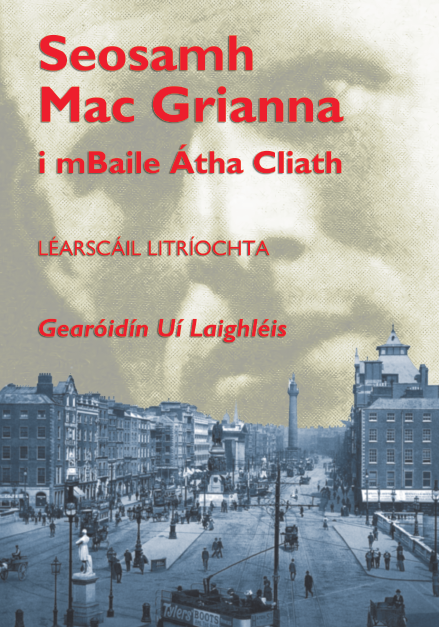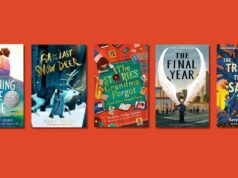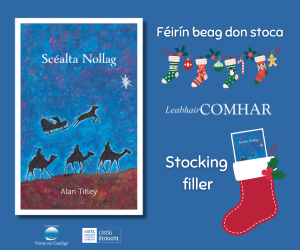
Seosamh Mac Grianna’s classic short stories—and restless life
An Grá agus an Ghruaim|Seosamh Mac Grianna|Ed Eoghan Mac Giolla Bhríde|Éabhlóid||Seosamh Mac Grianna i mBaile Átha Cliath: Léarscáil Litríochta|Gearóidín Uí Laighléis|Coiscéim
by Anna Heussaff
In a beautiful new edition from Éabhlóid, Eoghan Mac Giolla Bhríde’s Donegal publishing house, An Grá agus an Ghruaim is a much-loved classic collection of short stories by Seosamh Mac Grianna.
When it was first published in 1929, the fragile and deeply divided new state was in its infancy and so too was the development of a modern literature in Irish. Colonial suppression and marginalisation of the language over the previous centuries had almost severed its long written literary traditions, but a vibrant oral culture had continued wherever Irish was still spoken.
Mac Grianna grew up in Rann na Feirste, in west Donegal, in a family of storytellers, poets and singers. He read voraciously in English, and in his twenties, newly released from imprisonment during the Civil War, he set about creating his own distinct voice inspired by European realism as well as by the history, folklore and rich idioms of his upbringing.
When it was first published in 1929, the fragile and deeply divided new state was in its infancy and so too was the development of a modern literature in Irish

Many of the ten stories in this edition are memorable and one in particular, Ar an Tráigh Fhoilimh, is deeply moving and perfectly crafted. In Sracadh, the collection’s titular themes of love and despair are closely intertwined, as Brídeog, widowed by her husband’s drowning five years earlier, watches the crew of a capsized fishing boat desperately trying to reach the shore while her neighbour Eoghainín Mór, bereaved when his brother died alongside Brídeog’s husband, sets out to save them.
Fear, hardship and hope are skilfully blended as a small fishing community’s elemental contest with the sea is played out
Eoghainín is a large, brawny man and his character is evoked in two short sentences: Rinne sé gáire beag. Níor chualaidh aon duine ariamh ag déanamh gáire ard nó amaideach é. (He gave a small laugh. Nobody had ever heard him laugh loudly or stupidly.) Fear, hardship and hope are skilfully blended as a small fishing community’s elemental contest with the sea is played out.
In Slóite na bhFiann, a tense atmosphere of a different kind is created as Dargán and Nuala stay up late at night listening for Liam and his band of Irregulars who are hiding out in the hills and in need of a safe house. Píosa na nDeich bPighinn starts somewhat awkwardly as a young lad imagines how a coin found buried in a field was first lost. But the reader is soon drawn to the plight of the central character, Beití, an elderly woman toiling in a potato field in the 1820s, exhausted by hard labour and by the humiliations of trying to pay off her dead brother’s debts.
Echoes of folk tales are clear in Taisce an Úcaire, in which Conall Garbh decides to dig up buried gold treasure reputed to be guarded by a poisonous snake
Echoes of folk tales are clear in Taisce an Úcaire, in which Conall Garbh decides to dig up buried gold treasure reputed to be guarded by a poisonous snake. But Mac Grianna’s focus is less on the drama of will-he-won’t-he-succeed, and more on Conall’s demented obsessiveness as he tries to overcome superstition with reason. In Creach Choinn Uí Dhomhnaill, A.D. 1495, the author uses an epic style to depict a world of poets, chieftains, astute women and internecine warfare in an era when the whole of Ulster from Donegal Bay to the Glens of Antrim shared the same language and culture.
Along with all their merits, some of the short stories show flaws and the evident strivings of a young writer. But Mac Grianna’s skills are all the more significant considering his one really notable literary precedent in the 1920s was in the work of Connemara writer Pádraic Ó Conaire, who also combined harsh and poignant social realism with finely wrought, rich and entirely authentic language. And in this collection, Ar an Tráigh Fhoilimh is a story that most of us who read it at school or at college never forgot. It’s set in the bleak famine year of 1847, and in less than eight pages, Mac Grianna makes us feel the bitter cold, pain, despair and utter emptiness of a man whose humanity has been hollowed out by starvation.
Mac Grianna makes us feel the bitter cold, pain, despair and utter emptiness of a man whose humanity has been hollowed out by starvation
Cathal finds Art as cold as a rock in a corner of their dank cottage. He cannot even say a prayer for the soul that has wrenched itself out of the shrivelled body. Bhí dearmad déanta de Dhia aige, nó chonacthas dó go raibh dearmad déanta ag Dia de le fada riamh. (He had forgotten God, as it seemed to him that God had long ago forgotten him.) But Cathal still manages to tie Art’s body onto his own back, to carry him a few miles to the cemetery by the sea. There will be no wake or gathering of neighbours because as life has become harder, people have become strangers to one another. On his way, ‘carrying his own fate on his back’, he approaches a crowd jostling for broth being distributed near the ‘big house’, hoping for a drop to keep him alive a day or two longer. But he and his burden are pushed aside violently and he trudges on, impelled by his remaining shreds of love and dignity to dig a shallow grave.
Like Ó Conaire’s, Seosamh Mac Grianna’s personal life was extremely difficult. As well as short stories, he produced novels, essays, reviews and his famous novelistic memoir, Mo Bhealach Féin, along with highly accomplished translations into Irish of a dozen novels under the state-funded An Gúm scheme he grew to despise. But in 1935, worn out and suffering increasing mental illness, he gave up writing. By the end of the 1950s, his partner Peigí and their son Fionn had both died tragically, and Mac Grianna was admitted into Letterkenny’s psychiatric hospital where he lived out his last decades.
Many new insights into his restless life can be found in another newly published book, Seosamh Mac Grianna i mBaile Átha Cliath: Léarscáil Litríochta (Coiscéim 2024), in which Dr. Gearóidín Uí Laighléis traces 21 different addresses at which he lived in Dublin, with excerpts from the work he had underway at each of them.
This very interesting scholarly approach gives us glimpses of the flatlands of the 1920s,1930s and beyond
This very interesting scholarly approach gives us glimpses of the flatlands of the 1920s,1930s and beyond, such as the North Circular Road, Eccles Street and Mountjoy Square, and across the Liffey to Portobello, Rathmines and Haddington Road.
The book ends with a plaque erected in Mac Grianna’s memory in May 2023 in St. Anne’s Park in Raheny, Dublin, marking the site of a rundown cottage near the coast road in which he lived during the 1940s and 1950s. A larger format for the book could have enhanced the presentation of maps and translation excerpts in Irish and in English, but for readers savouring An Grá agus an Ghruaim and other highlights of Mac Grianna’s enduring legacy, it will make a very welcome addition to the shelf.

Anna Heussaff is an award-winning novelist writing in Irish for adults and for young teens. Her latest crime novel, Sa Pholl Báite (CIC 2023) was reviewed in Books Ireland as ‘a lively and intriguing who-done-it from start to finish’.













